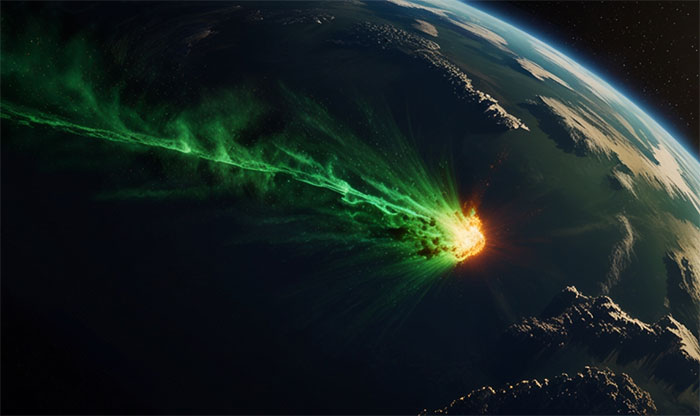Halloween Object Suddenly Loses Its 'Heart' Before Earthlings' Eyes
An ancient object expected to be bright enough to be easily seen with the naked eye on Halloween may be meeting a gruesome death.
According to Science Alert , a newly discovered object named C/2024 S1 was predicted to have a beautiful light show on Halloween this year.
However, the latest data shows that its "heart" appears to have disappeared.

Ancient object C/2024 S1 may have suffered nuclear disintegration before it could show Earth its best Halloween moment - (AI illustration: Anh Thu).
C/2024 S1 is a rare Kreutz sungrazer comet , expected to reach perihelion (closest point to the Sun) on October 28.
The Kreutz Sungrazer comets are a group of objects believed to be the remains of a larger comet, billions of years old, that appeared in the year 1106.
This family of comets includes 1965's Ikeya-Seki, which was nearly as bright as the full moon in the sky.
As for C/2024 S1, it was predicted to become a bright ball of light in Earth's sky thanks to its sublimation during the perihelion phase.
But then something went wrong: Images taken of the object in October showed it brightening with explosive activity before fading, with the nucleus appearing to disappear.
The event also left behind a trail of dust and gas, which astronomers speculate was a cloud of cometary debris.
This was a bit disappointing, but not entirely surprising, as this was not the first time Earthlings had witnessed a comet breaking up right before their eyes.
In 2020, comet C/2019 Y4 broke into pieces as it approached the Sun under the monitoring of the Hubble Space Telescope.
With C/2024 S1, there were signs of trouble earlier, including an outburst in which a lot of dust and gas suddenly escaped, causing it to brighten significantly for a few days.
Images taken on October 20 and 22 by Czech amateur astronomer Martin Mašek also show that at some point the comet's nucleus appeared to have disappeared from view.

Images show the comet suddenly dimmed a few days ago - (Photo: Martin Mašek).
A large piece of the nucleus may survive the decay and continue its journey, while the tail may remain visible even as the comet nucleus decays, so it's not unusual to still see it - just dimmer.
Currently, C/2024 S1 can be seen with binoculars or a small telescope in the Southern Hemisphere.
After perihelion, if part of its "heart" survives, it will be visible in the Northern Hemisphere.
Conversely, if the nucleus disintegrates completely as it approaches the Sun, we can still see its long, curved tail faintly, but without the expected bright cometary head.
- NASA suddenly launched the Halloween face of the Sun.
- Halloween ghost festival and things you don't know yet
- Mysterious dishes during the Halloween devil feast
- Extremely rare photos: Halloween festivals from 1900 to 1920
- Sculptures inspired by Halloween
- Halloween festival
- The scientific origin of Halloween monsters
- The 16 tough jokes waiting for Halloween are scare people
- Learn about Halloween festivals
- Research proves that Halloween is a festival of love
- The mysterious legends of Halloween
- Every Halloween sees demon face pumpkins but does anyone know the true story behind?
 Van Allen's belt and evidence that the Apollo 11 mission to the Moon was myth
Van Allen's belt and evidence that the Apollo 11 mission to the Moon was myth The levels of civilization in the universe (Kardashev scale)
The levels of civilization in the universe (Kardashev scale) Today Mars, the sun and the Earth are aligned
Today Mars, the sun and the Earth are aligned The Amazon owner announced a secret plan to build a space base for thousands of people
The Amazon owner announced a secret plan to build a space base for thousands of people